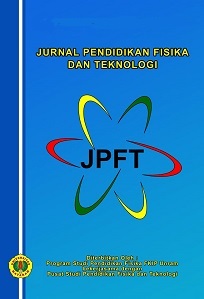Implementation of Problem-Based Learning Model to Improve High School Students' Problem-Solving Ability on Physics Materials
DOI:
10.29303/jpft.v10i2.6902Published:
2024-09-20Issue:
Vol. 10 No. 2 (2024): July - DecemberKeywords:
Problem-Based Learning, Problem Solving SkillArticles
Downloads
How to Cite
Downloads
Metrics
Abstract
This research aims to see whether there is an influence of the problem-based learning model on students' problem-solving abilities in physics material at SMAN 9 Gowa. This research is Pre-Experimental research using One Group Pretest-Posttest Design so that only one class without control class. The population of this study were students of class XI MIPA 1 until XI MIPA 5. The research sample was taken using a simple random class technique, namely class XI MIPA 5 SMAN 9 Gowa. The research instrument is a test instrument for students' physics problem solving abilities in the form of 6 selected essays that use the valid criteria. The research results showed that the physics solving abilities of class XI MIPA 5 students before being taught by applying the problem based learning model were in the low problem category as indicated by the average score of 42.5. Problem solving ability of students before the application of the PBL model is 64% in the medium category, 32% in the low category and 4% in the very low category. The ability to solve physics problems of class XI MIPA 5 students after being taught by applying the problem based learning model is in the high category as shown by the average score of 61.7. Problem solving ability of students after applying the PBL model is 56% in the high category, and 44% in the medium category and nothing student have low and very low problem solving ability. In the pretest, problem solving ability has the lowest score is 19, the highest score is 47 and the average score is 42.5 which is in the medium category with a standard deviation is 6.7, while in the posttest, the lowest score is 50, the highest score is 75, and the average score is 61.7 which is in the high category with a standard deviation is 6.8. There was a significant increase in the physics problem solving abilities of class XI MIPA 5 students after being taught using the problem-based learning model with the N-Gain category = 0.34 (medium criteria).
References
Hasanah, M., & Fitria, Y. (2021). Pengaruh Model Problem Based Learning Terhadap Kemampuan Kognitif Ipa Pada Pembelajaran Tematik Terpadu. Jurnal Basicedu, 5(3), 1509–1517. Https://Doi.Org/10.31004/Basicedu.V5i3.968. DOI: https://doi.org/10.31004/basicedu.v5i3.968
Imandala, I., Li, R., & Supriyadi, A. (2019). Analysis of problem-based learning models by typology of knowledge Pollock and Cruz (1999). Journal of the Korean Academy of Fundamentals of Nursing, 27(3), 246–258. https://doi.org/10.7739/jkafn.2020 .27.3.246.
Martawijaya Agus, Haris & Rahmania. (2015). Kemampuan Merumuskan Hipotesis Fisika Peserta Didik Kelas X MIA SMA Barang Lompoa. Jurnal Pendidikan Fisika Universitas Muhammadiyah Makassar.
Ngalimun. (2017). Strategi Pembelajaran. Yogyakarta: Param Ilmu.
Novitri, (2017). Penerapan model Problem Based Learning Dengan Pendekatan Saintifik Untuk Meningkatkan Hasil Belajar dan Kemampuan Pemecahan Masalah Siswa di Kelas VIII.8 SMPN 1 Kota Bengkulu. Jurnal Pendidikan Fisika. DOI: https://doi.org/10.24036/02017117932-0-00
Pebriyani, E. P., & Pahlevi, T. (2020). Pengaruh Model Pembelajaran Problem Based Learning (PBL) Terhadap Kemampuan Berpikir Kritis Dan Hasil Belajar Peserta Didik Pada Mata Pelajaran Kearsipan Kelas X Otkp Di SMK Negeri 1 Sooko Mojokerto. Jurnal Pendidikan Administrasi Perkantoran (Jpap), 8(1), 47–55. Https://Doi.Org/10.26740/Jpap.V8n1.P47-55. DOI: https://doi.org/10.26740/jpap.v8n1.p47-55
Prasekti, E. D., & Marsigit, M. (2017). Perbandingan keefektifan metode problem-based learning dan project-based learning pada pembelajaran statistika SMA. Pythagoras: Jurnal Pendidikan Matematika, 12(2), 161–172. https://doi.org/10.21831/pg.v12i2.17714. DOI: https://doi.org/10.21831/pg.v12i2.17714
Setyaningsih, R., & Rahman, Z. H. (2022). Pengaruh Model Problem Based Learning Terhadap Kemampuan Pemecahan Masalah Siswa. AKSIOMA: Jurnal Program Studi Pendidikan Matematika, 11(2), 1606-1619. DOI: https://doi.org/10.24127/ajpm.v11i2.5098
Sugiyono. (2016). Statistika Untuk Penelitian. Bandung: Alfabeta.
Sugiyono. (2017). Metode Penelitian kuantitatif kualitatif dan R&D. Bandung: Alfabeta.
Veronica T., Swistoro, E., & Hamdani, D. (2018). Pengaruh Pembelajaran dengan Model Problem Solving Fisika Terhadap Hasil Belajar dan Kemampuan Pemecahan Masalah Fisika Kelas XI IPA SMA Negeri 1 Lebong. Jurnal Kumparan Fisika Universitas Bengkulu. DOI: https://doi.org/10.33369/jkf.1.2.31-39
Wijayanti, A. P., Sumarmi, & Amirudin, A. (2016). Perbandingan Model Group Investigation Dengan Problem Based Learning Berbasis Multiple Intelligence Terhadap Kemampuan Memecahkan Masalah Siswa SMA. Jurnal Pendidikan: Teori, Penelitian, Dan Pengembangan, 1(5), 948– 957. http://journal.um.ac.id/index.php/j ptpp/article/view/6326.
Yasa, P. A. E. M., & Bhoke, W. (2019). Pengaruh Model Problem Based Learning Terhadap Hasil Belajar Matematika Pada Siswa SD. Journal of Education Technology, 2(2), 70–75. DOI: https://doi.org/10.23887/jet.v2i2.16184
Author Biographies
Aisya R, State University of Makassar
Physics Education Study Program
Usman Usman, Universitas Negeri Makassar
Khaeruddin Khaeruddin, State University of Makassar
Physics Education Study Program
Trisno Setiawan, State University of Makassar
Physics Education Study Program
License
Copyright (c) 2024 Aisya R, Usman Usman, Khaeruddin Khaeruddin, Trisno Setiawan

This work is licensed under a Creative Commons Attribution-ShareAlike 4.0 International License.
Authors who publish with Jurnal Pendidikan Fisika dan Teknologi (JPFT) agree to the following terms:
- Authors retain copyright and grant the journal right of first publication with the work simultaneously licensed under a Creative Commons Attribution License 4.0 International License (CC-BY-SA License). This license allows authors to use all articles, data sets, graphics, and appendices in data mining applications, search engines, web sites, blogs, and other platforms by providing an appropriate reference. The journal allows the author(s) to hold the copyright without restrictions and will retain publishing rights without restrictions.
- Authors are able to enter into separate, additional contractual arrangements for the non-exclusive distribution of the journal's published version of the work (e.g., post it to an institutional repository or publish it in a book), with an acknowledgement of its initial publication in Jurnal Pendidikan Fisika dan Teknologi (JPFT).
- Authors are permitted and encouraged to post their work online (e.g., in institutional repositories or on their website) prior to and during the submission process, as it can lead to productive exchanges, as well as earlier and greater citation of published work (See The Effect of Open Access).











